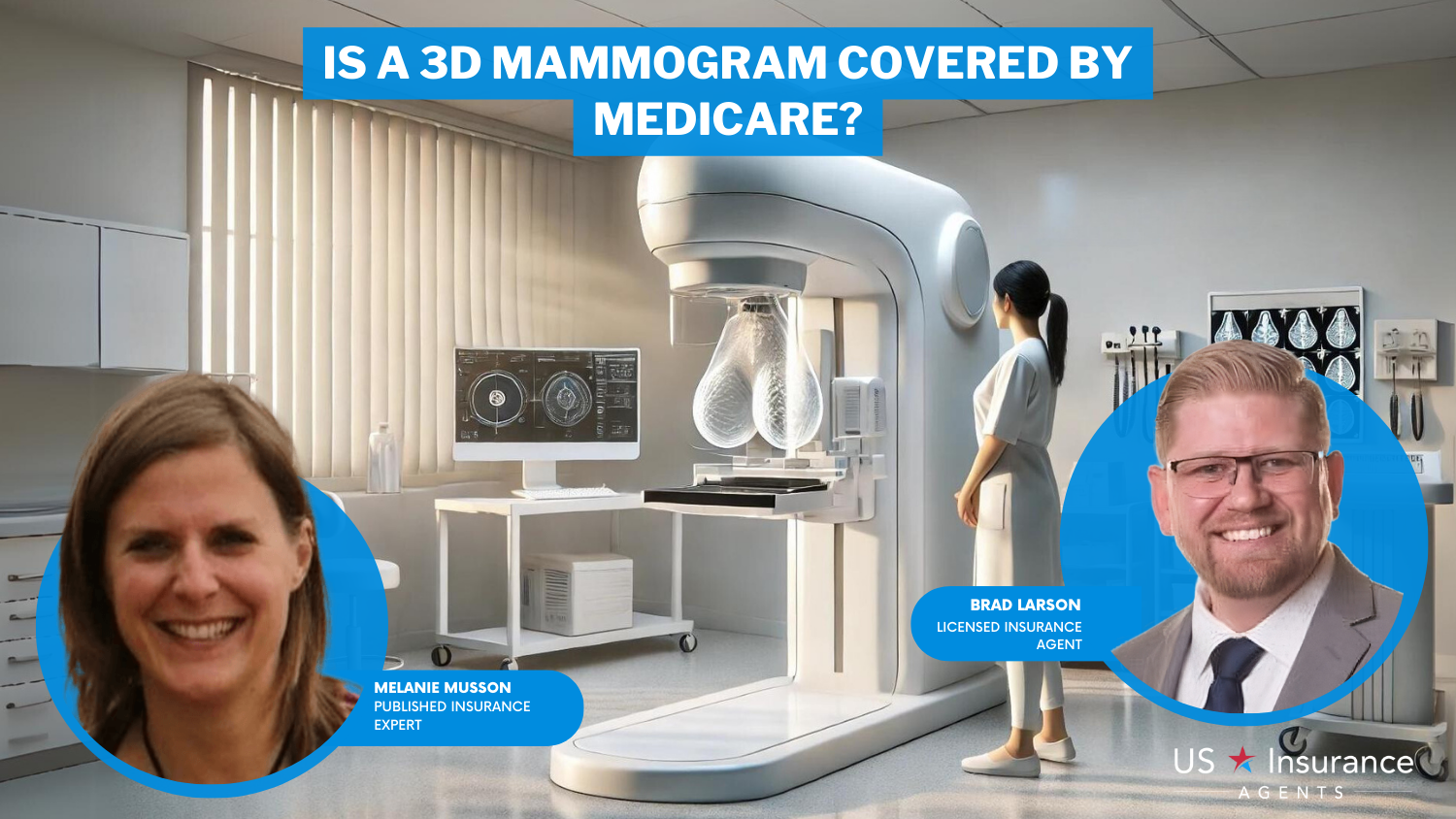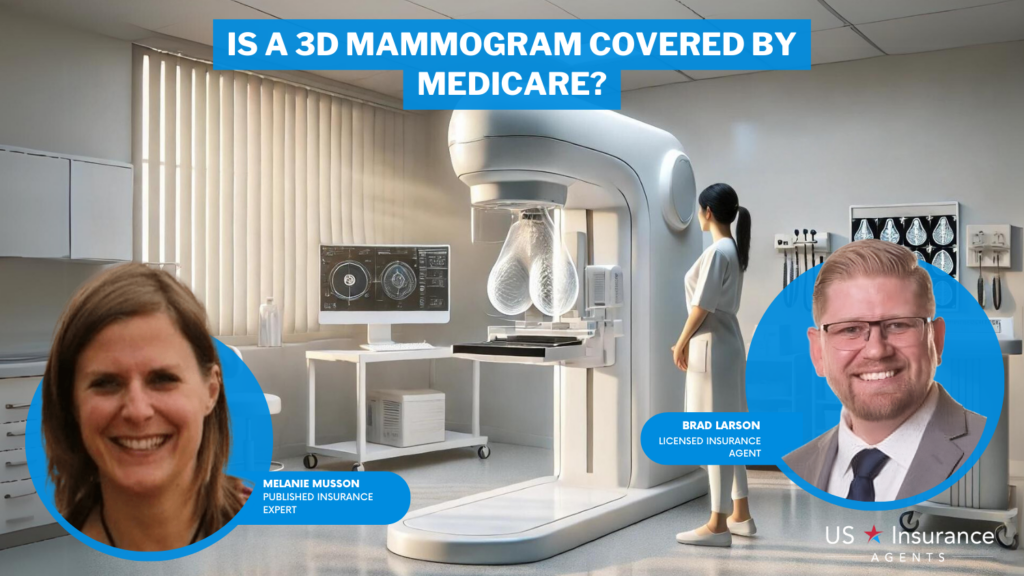Is a 3D mammogram covered by Medicare?
Navigate the intricacies of Medicare policies and gain clarity on whether 3D mammograms are covered. Explore the benefits and potential limitations of this advanced screening technology. Understand the criteria for eligibility, potential costs, and coverage considerations. Stay informed and make empowered decisions about your breast health.
Read moreFree Medicare Insurance Comparison
Compare Quotes From Top Companies and Save
Secured with SHA-256 Encryption

Brad Larson
Licensed Insurance Agent
Brad Larson has been in the insurance industry for over 16 years. He specializes in helping clients navigate the claims process, with a particular emphasis on coverage analysis. He received his bachelor’s degree from the University of Utah in Political Science. He also holds an Associate in Claims (AIC) and Associate in General Insurance (AINS) designations, as well as a Utah Property and Casual...
Licensed Insurance Agent
UPDATED: Jan 16, 2025
It’s all about you. We want to help you make the right coverage choices.
Advertiser Disclosure: We strive to help you make confident insurance decisions. Comparison shopping should be easy. We are not affiliated with any one insurance company and cannot guarantee quotes from any single insurance company.
Our insurance industry partnerships don’t influence our content. Our opinions are our own. To compare quotes from many different insurance companies please enter your ZIP code above to use the free quote tool. The more quotes you compare, the more chances to save.
Editorial Guidelines: We are a free online resource for anyone interested in learning more about insurance. Our goal is to be an objective, third-party resource for everything insurance related. We update our site regularly, and all content is reviewed by insurance experts.
UPDATED: Jan 16, 2025
It’s all about you. We want to help you make the right coverage choices.
Advertiser Disclosure: We strive to help you make confident insurance decisions. Comparison shopping should be easy. We are not affiliated with any one insurance company and cannot guarantee quotes from any single insurance company.
Our insurance industry partnerships don’t influence our content. Our opinions are our own. To compare quotes from many different insurance companies please enter your ZIP code above to use the free quote tool. The more quotes you compare, the more chances to save.
On This Page
Welcome to our comprehensive guide on the topic “Is a 3D mammogram covered by Medicare?”

We provide you with valuable insights and information to help you understand the coverage options and eligibility criteria for 3D mammograms under Medicare. Explore the benefits, limitations, and the importance of early detection.
- Annual 3D mammograms used for screening purposes in women over the age of 40 are covered by Medicare
- Medicare will also cover the costs of one baseline mammogram for women between the ages of 35 and 39
- If a diagnostic mammogram is medically necessary, Medicare will cover 80% of the approved amount
To ensure you have the best insurance provider offering coverage for 3D mammograms, enter your zip code now and compare rates. Take control of your breast health and make informed decisions to prioritize your well-being.
Does Medicare cover 2D and 3D mammograms?
Traditional 2D mammograms take images of breast tissue from the sides and front to create an overlapping image. 3D mammograms use images from multiple angles for a clearer, more detailed final image.
While both are considered effective, 3D mammograms can be more precise and accurate. And if it sounds like a 3D mammogram may be more expensive, you’re right.
Fortunately, if you have Medicare and your doctor recommends a 3D mammogram, you won’t have to worry — Medicare covers 2D and 3D mammograms the same.
Compare The Best Insurance Quotes In The Country
Compare quotes from the top insurance companies and save!
Secured with SHA-256 Encryption
Which 3D mammograms are covered by Medicare?
While 3D mammograms are covered by Medicare, some scenarios could leave you with some out-of-pocket costs. It’s important that you understand the different classifications of mammograms so you can accurately budget your healthcare costs.
Baseline Mammograms
Your very first mammogram screening is referred to as your baseline. This can be 2D or 3D.
For women with no known cancer risks or family history of breast cancer, this may not be recommended until you reach the age of 50. However, you may have a higher risk for breast cancer if you:
- Have dense breast tissue
- Have a family history of breast or ovarian cancer
- Have a personal history of breast disease or cancer
In these situations, your doctor may recommend that you schedule a baseline mammogram as early as 35. Medicare will cover one baseline mammogram for members between the ages of 35 and 39.
Screening Mammograms
A screening mammogram is used on an annual basis to monitor breast tissue for any potential changes. Screening mammograms are the most common type and are completely covered by Medicare for people ages 40 and older, as long as they are at least one full calendar year apart.
You may not need a mammogram once a year. Some doctors recommend one every two years. Regardless of the schedule you and your doctor decide on, Medicare will cover the costs entirely as long as it has been at least one full year since your last mammogram.
Diagnostic Mammograms
A doctor often recommends a diagnostic mammogram if you develop any signs or symptoms that require further testing. This could be for a variety of reasons, including:
- Chronic breast pain or tenderness
- The development of a lump or mass
- Changes in breast size or shape
- Abnormalities found on a screening mammogram
A diagnostic mammogram is part of your doctor’s plan to diagnose and treat a medical condition, separating this type of mammogram from the others. In this situation, you should be prepared to pay for part of the cost on your own.
How much do mammograms cost?
If you need a diagnostic mammogram and you have Medicare, your Part B plan will cover 80% of the Medicare-approved amount. After you meet your annual deductible, you will have to pay the other 20%.
Keep in mind that if the cost of the 3D mammogram is higher than the Medicare-approved amount, you’ll also be responsible for the difference. For example, let’s assume you’ve met your deductible for the year, which is $233 for 2022.
You could schedule a diagnostic mammogram at a facility that charges $120 for a 3D mammogram, but your Medicare plan may only approve a maximum amount of $100.
Medicare Part B will cover 80% of this approved amount, which is $80. You would be responsible for the other 20%, which is $20. However, you would also have to pay the extra $20 that was over the Medicare-approved amount. So in this scenario, your total out-of-pocket costs would be $40.
Remember, the costs will vary based on where you live and which office you choose. You can check the official government website for up-to-date Medicare costs.
How To Limit Out-of-Pocket Costs for 3D Mammograms
If your doctor recommends a 3D mammogram, choose a facility that accepts Medicare plans. You can also contact the office before the appointment to find out your total costs and what your Medicare plan will cover.
Some people choose to sign up for Medicare Advantage plans or add supplemental insurance to Medicare to help with out-of-pocket expenses. If you have one of these plans, contact the company to find out exactly what’s covered.
3D Mammograms and Medicare: The Essential Facts
3D mammograms are one of the most reliable and accurate ways to detect breast cancer and other diseases. Medicare will cover the entire cost for baseline and yearly mammograms, assuming you fall within the approved age range.
Most people can expect to pay 20% of the cost of a medically-necessary diagnostic mammogram after meeting their Medicare B deductible. If you’re looking for help paying for out-of-pocket medical expenses, you may want to consider a Medicare supplement plan.
Compare The Best Insurance Quotes In The Country
Compare quotes from the top insurance companies and save!
Secured with SHA-256 Encryption
Case Studies: Is a 3D Mammogram covered by Medicare?
Case Study 1: Jane’s Experience
Jane, a Medicare beneficiary, recently underwent a routine mammogram. Concerned about the accuracy of traditional 2D mammograms, she requested a 3D mammogram instead. However, Jane’s healthcare provider informed her that Medicare does not cover the cost of 3D mammograms unless specific criteria are met.
Despite her preference for the advanced imaging technique, Jane had to proceed with a conventional 2D mammogram due to Medicare’s coverage limitations.
Case Study 2: Robert’s Journey
Robert, a Medicare recipient, had a family history of breast cancer. Aware of the potential benefits of 3D mammography, he decided to explore the coverage options available. Robert discovered that Medicare covers 3D mammograms for individuals with dense breast tissue or those with a history of breast cancer.
He obtained a referral from his physician and was able to receive a 3D mammogram at a participating facility covered by Medicare.
Case Study 3: Sarah’s Challenges
Sarah, another Medicare beneficiary, had undergone a 3D mammogram a few years ago and found it to be more effective in detecting abnormalities compared to the traditional method. However, when she scheduled her next mammogram, she faced difficulty finding a facility that offered 3D mammograms covered by Medicare.
Despite being willing to pay the additional cost, Sarah’s options were limited, and she had to settle for a 2D mammogram covered by Medicare.
Case Study 4: John’s Exceptional Circumstance
John, a Medicare recipient with a history of breast cancer, required regular mammograms for post-treatment monitoring. Due to his unique circumstances, including previous surgical interventions and the need for more precise imaging, his healthcare provider deemed 3D mammography necessary. In John’s case, Medicare made an exception and covered the cost of his 3D mammograms as part of his ongoing cancer care.
Frequently Asked Questions
What is a 3D mammogram?
A 3D mammogram, also known as digital breast tomosynthesis (DBT), is a type of breast cancer screening that uses low-dose X-rays to create multiple images of the breast from different angles. This allows for a more detailed and accurate view of the breast tissue compared to a traditional 2D mammogram.
Is a 3D mammogram covered by Medicare?
Yes, Medicare covers 3D mammograms for eligible beneficiaries. Medicare considers DBT to be a preventive service and covers it once every 12 months for women who meet certain criteria.
Who is eligible for Medicare coverage of a 3D mammogram?
Medicare covers 3D mammograms for women who are 40 years of age or older and have not had a previous breast cancer diagnosis.
Is a referral needed for a 3D mammogram covered by Medicare?
Yes, a referral from a healthcare provider is required for Medicare coverage of a 3D mammogram.
Are there any out-of-pocket costs associated with a 3D mammogram covered by Medicare?
Medicare covers the full cost of a 3D mammogram once every 12 months, with no deductible or coinsurance required. However, if additional imaging or diagnostic tests are needed, there may be out-of-pocket costs.
Compare The Best Insurance Quotes In The Country
Compare quotes from the top insurance companies and save!
Secured with SHA-256 Encryption
Brad Larson
Licensed Insurance Agent
Brad Larson has been in the insurance industry for over 16 years. He specializes in helping clients navigate the claims process, with a particular emphasis on coverage analysis. He received his bachelor’s degree from the University of Utah in Political Science. He also holds an Associate in Claims (AIC) and Associate in General Insurance (AINS) designations, as well as a Utah Property and Casual...
Licensed Insurance Agent
Editorial Guidelines: We are a free online resource for anyone interested in learning more about insurance. Our goal is to be an objective, third-party resource for everything insurance related. We update our site regularly, and all content is reviewed by insurance experts.